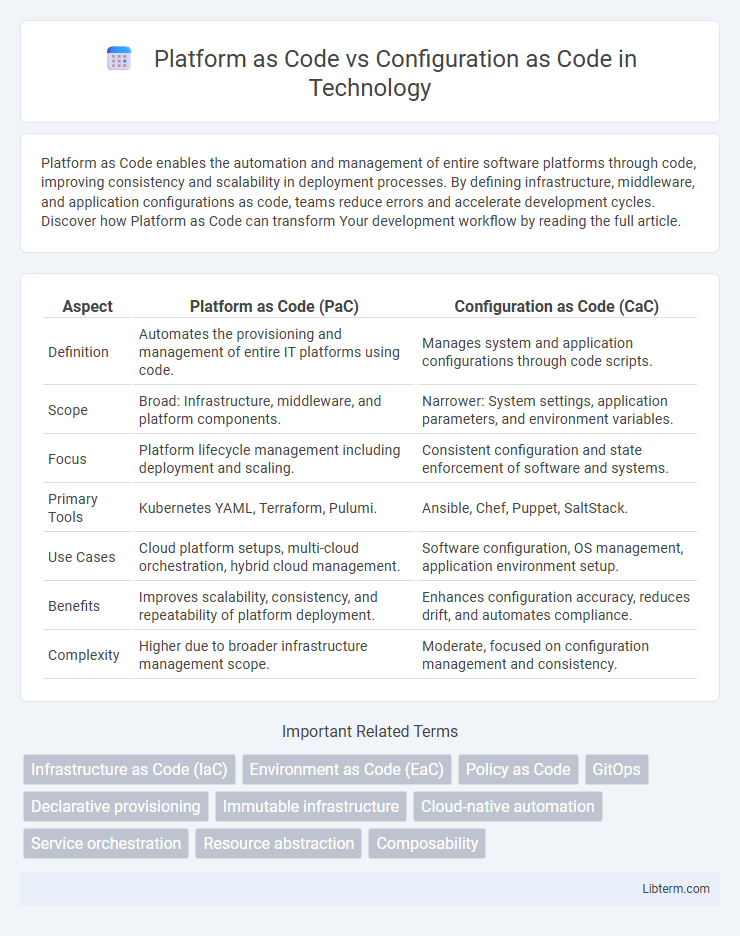Platform as Code enables the automation and management of entire software platforms through code, improving consistency and scalability in deployment processes. By defining infrastructure, middleware, and application configurations as code, teams reduce errors and accelerate development cycles. Discover how Platform as Code can transform Your development workflow by reading the full article.
Table of Comparison
| Aspect | Platform as Code (PaC) | Configuration as Code (CaC) |
|---|---|---|
| Definition | Automates the provisioning and management of entire IT platforms using code. | Manages system and application configurations through code scripts. |
| Scope | Broad: Infrastructure, middleware, and platform components. | Narrower: System settings, application parameters, and environment variables. |
| Focus | Platform lifecycle management including deployment and scaling. | Consistent configuration and state enforcement of software and systems. |
| Primary Tools | Kubernetes YAML, Terraform, Pulumi. | Ansible, Chef, Puppet, SaltStack. |
| Use Cases | Cloud platform setups, multi-cloud orchestration, hybrid cloud management. | Software configuration, OS management, application environment setup. |
| Benefits | Improves scalability, consistency, and repeatability of platform deployment. | Enhances configuration accuracy, reduces drift, and automates compliance. |
| Complexity | Higher due to broader infrastructure management scope. | Moderate, focused on configuration management and consistency. |
Introduction to Platform as Code and Configuration as Code
Platform as Code (PaC) automates the provisioning and management of cloud infrastructure using declarative code, enabling consistent and repeatable environment setups. Configuration as Code (CaC) defines system and application settings through code, ensuring precise control over software deployments and configurations. Both approaches enhance DevOps practices by promoting infrastructure automation and minimizing manual errors.
Defining Platform as Code (PaC)
Platform as Code (PaC) is a methodology that automates the provisioning and management of the entire software platform, including infrastructure, middleware, and runtime environments, through declarative code. It enables consistent, reusable, and version-controlled platform components that support continuous integration and delivery pipelines. PaC differs from Configuration as Code by encompassing higher-level abstraction and broader scope beyond mere configuration settings, focusing on platform lifecycle automation.
Defining Configuration as Code (CaC)
Configuration as Code (CaC) involves managing and defining system configurations through machine-readable files, enabling automated and consistent environment setups. Unlike Platform as Code, which encompasses the provisioning of entire infrastructure platforms, CaC specifically targets the declarative specification of application and service settings. Tools such as Ansible, Puppet, and Chef facilitate CaC by ensuring version-controlled, repeatable, and auditable configuration management processes.
Key Differences Between PaC and CaC
Platform as Code (PaC) manages entire infrastructure platforms through automated code, enabling consistent provisioning and lifecycle management of resources like compute, storage, and network services. Configuration as Code (CaC) focuses specifically on the automated setup and management of software configurations and applications within an environment, ensuring consistency in application deployment and settings. Key differences include PaC's broader scope covering complete infrastructure orchestration, while CaC targets detailed software and system configuration management, often layered on top of PaC frameworks.
Benefits of Platform as Code
Platform as Code enables full automation and version control of the entire platform infrastructure, delivering improved consistency, faster deployments, and enhanced scalability over Configuration as Code. By managing the platform holistically, it reduces manual errors, simplifies maintenance, and accelerates innovation cycles. This approach supports complex environments more effectively, ensuring robust governance and easier compliance management.
Advantages of Configuration as Code
Configuration as Code offers the advantage of greater automation by enabling infrastructure and application settings to be defined declaratively within version-controlled files, ensuring consistency and reproducibility across environments. It improves collaboration between development and operations teams through standardized configurations that reduce human error and streamline deployment workflows. This approach also facilitates rapid rollback and auditability, enhancing security and compliance management.
Use Cases for Platform as Code
Platform as Code (PaC) enables developers to automate the entire cloud infrastructure, including networks, storage, and compute resources, making it ideal for deploying complex multi-cloud environments and scalable microservices architectures. Use cases for Platform as Code involve continuous delivery pipelines, disaster recovery automation, and dynamic resource provisioning driven by application requirements. By contrast, Configuration as Code primarily manages software settings and application deployment states within predefined infrastructure, focusing on environment consistency and system configuration management.
Use Cases for Configuration as Code
Configuration as Code is primarily used for managing system settings, application configurations, and infrastructure parameters to ensure consistency and repeatability across environments. It enables automated deployment, environment provisioning, and scaling by defining configurations in code, which reduces manual errors and improves collaboration between development and operations teams. Typical use cases include version-controlled configuration files for software applications, setting up continuous integration/continuous deployment (CI/CD) pipelines, and managing cloud infrastructure settings.
Challenges and Considerations
Platform as Code challenges include complexity in managing infrastructure dependencies and ensuring consistent environment provisioning, which demands advanced orchestration tools and robust version control systems. Configuration as Code faces issues in maintaining configuration drift, handling secrets management, and ensuring idempotency for reliable deployment across diverse environments. Both approaches require strong validation, testing frameworks, and collaboration between development and operations teams to minimize errors and optimize automation workflows.
Choosing the Right Approach for Your Organization
Choosing between Platform as Code (PaC) and Configuration as Code (CaC) depends on organizational goals and technical maturity. PaC provides end-to-end automation of infrastructure and application deployments, enabling consistent platform-wide management, while CaC focuses primarily on managing application and service configurations within existing platforms. Organizations seeking comprehensive environment control with scalability benefits should lean towards PaC, whereas teams prioritizing rapid, incremental configuration changes might find CaC more suitable for their workflows.
Platform as Code Infographic

 libterm.com
libterm.com